ホーム > 観光・名産 > 観光・レジャー > 観光・名所 > 観光ポータルサイト「旅たび相模」 > 神奈川県県央地域(宮ヶ瀬湖・相模原)の寺社・史跡・文化財
更新日:2025年10月16日
ここから本文です。
神奈川県県央地域(宮ヶ瀬湖・相模原)の寺社・史跡・文化財
神奈川県県央地域の寺社・史跡・文化財情報です。
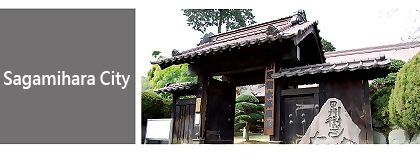

Site of Taima Ferry
Located at Showa Bridge, the site of Taima Ferry was a major transportation hub that has connected Taima (Sagamihara City) and Echi (now Atsugi City) since ancient times. In the old days, people who made Mount Oyama pilgrimages used the ferry here.

Tana Hachimangu Shrine
Tana Hachimangu Shrine has a history of more than ten centuries. Local people and visitors love the shishimai lion dance dedicated to the gods at the annual festival in September.

Historic Site Tana Mukaihara Remains Paleolithic Study Center (Paleolith HATENA House)
At this exhibition facility about Japan's Paleolithic Age, you can join various hands-on classes. The adjacent Archeological Site Park has the remains of buildings from the Paleolithic Age as well as reconstructed houses from the Jomon Period (c. 10,000 BC to 300 BC).

Taimasan Muryokoji Temple
The grounds of Taimasan Muryokoji Temple are designated as a Sagamihara City Designated Historic Site, and have also been chosen as one of the "Top 50 Scenic Views in Kanagawa." The temple gate is a Sagamihara City Designated Tangible Cultural Property, and the Tokuhon Nenbutsu pagoda stored on the temple grounds is a Sagamihara City Registered Tangible Cultural Property.

Obarajuku Honjin
The Obarajuku Honjin was used as a honjin-an official inn for feudal lords and others of high rank-during the Edo Period (1603-1868). It is designated as a Kanagawa Prefecture Important Cultural Property.

Shokakuji Temple
Shokakuji Temple, also known as the haiku temple, is known for its many haiku monuments by both famous and obscure authors. It is also famous for the flowers on the temple grounds, such as the taki-tsutsuji, a waterfall-like formation of rhododendron flowers, and the goshoku tsubaki (five-colored Japanese camellia), making it a popular photo spot for those seeking a seasonal atmosphere. It is also one of the temples on the Tsukui Kannon Pilgrimage.

Ogura Bridge
Ogura Bridge is a beautiful retro arch bridge completed in 1938. It has been selected as one of the "Top 50 Scenic Views in Kanagawa," "Top 100 Beautiful Bridges in Kanagawa," and the "Eight Views of Sagami River." It was designated as a Sagamihara City Registered Tangible Cultural Property in 2015.

Old Seiryuji Temple Historical Residence (Old 'Minka-en' House Garden)
The former kuri (kitchen) of Seiryuji Temple, located within Sagamihara Nature Village Park, is an old residential house with a thatched roof thought to have been built in the middle of the Edo Period (early 1700s).

Yoshinojuku Fujiya
Yoshinojuku Fujiya, built around 1897, is a townhouse building that retains the atmosphere of what was once Yoshino Station on the Koshu Kaido, one of the five main routes to Edo (old Tokyo). It was designated a Sagamihara City Registered Cultural Property in 2014. The old-fashioned atmosphere of the structure makes it a popular photo spot.

Hosenji Temple
Koyasan Shingon sect, Shohuzan Hosenji Temple is the sixth temple of the pilgrimage of 33 Kannon Temples in Tsukui. Constructed in 2009, the wooden main hall sits against the backdrop of the forest on the rolling hills, where Komatsu Castle once stood. You can feel the brilliance of the hall with the refreshing aroma of timbers. Hosenji Temple is also known as a “Cat Temple.”
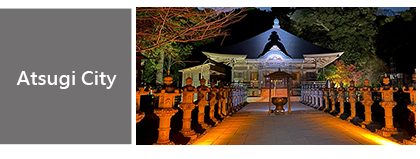

Site of Atsugi Ferry
Along the Sagami River, a bit upstream from Ayumi Bridge, is the site of Atsugi Ferry. The site has stone monuments indicating that it is a ferryboat dock as well as one that commemorates the visit of Watanabe Kazan, an Edo Period painter.

Old 'Minka' Folk House:Kishi House
Built in 1891, Kishi House is a two-story wooden house with a tiled, hipped roof. It is designated an Atsugi City Tangible Cultural Property.

Iiyama Kannon (Kannon at Chokokuji Temple)
Kannon Hall of Chokokuji Temple, the sixth temple on the Bando 33 Kannon Pilgrimage, has a pyramidal copper-shingle roof and is designated as an Atsugi City Tangible Cultural Property. Widely known as the "Kannon of Matchmaking," it is a tourist attraction for young people.

Ogama Benzaiten
Located beside the upper reaches of the Osawa River, Ogama Benzaiten is a shrine dedicated to the god Benzaiten as a place to pray for rain. It is named "Ogama" (Giant Cauldron) because the waterfall basin is shaped like a cauldron. It is a sacred spot with great spiritual significance.
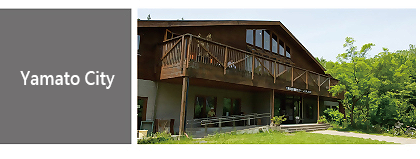

Stone pillar of Yagurasawa Okan
The Yagurasawa Okan was an old road leading from Akasaka Gate in Edo (now Tokyo) to Yagurasawa in Minami-Ashigara, past Ashigara Pass to Numazu and Mishima in Suruga Province (now Shizuoka Prefecture). As a side road of the Tokaido Road, it was an important political and economic road that connected the East and West.

Josenji Temple
Josenji Temple is located in a serene area surrounded by nature, and seasonal flowers adorn the temple grounds year-round. In particular, the temple is famous for its mitsumata flowers in the spring and white equinox flowers in the fall.

Shimo-Tsuruma Furusato Kan (Old 'Minka' Ogura House)
The Shimo-Tsuruma Furusato Kan is a folk museum and reconstruction of the main house and storage house of the former Ogura family residence, a Yamato City Designated Important Cultural Property. The main house, built in 1856, is one of the few station-area merchant houses in the prefecture.

Yamato City Kyodo Minka-en (Old 'Minka' Folk House Museum)
Yamato City Kyodo Minka-en is a 3,800-square-meter facility in Izuminomori Park. Two traditional city residences were relocated to these grounds and restored, and together they are designated a Yamato City Important Cultural Property. The park is also the source of the Hikichi River.
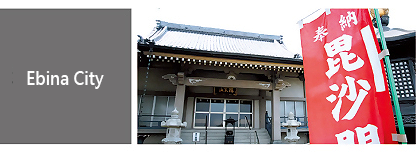

Sagami Kokubunji Temple
Sagami Kokubunji is a temple belonging to the Koyasan Shingon sect of Buddhism. The honzon (main image) is the Yakushi Sanzon statue. The temple's bronze bell was donated in 1292 and was made by famed craftsman Mononobe Kunimitsu.

Imafuku-yakuimon Park (The old Imafuku residence)
Imafuku-yakuimon Park (The old Imafuku residence) was once the site of the Imafuku family's residence, and is home to trees with medicinal properties as well as rare plants and flowers. It is a very quiet historical park surrounded by greenery, with a warehouse and yakuimon (roofed gate) built around 1850 at the end of the Edo Period.

Sagami Kokubunji Ato (Historic site)
The Sagami Kokubunji Ato was developed as a historical park and opened to the public, providing a place of relaxation for residents and visitors.

Sagami Shichifukujin
Sagami Shichifukujin refers to seven temples in the cities of Ebina and Zama, each dedicated to one of the Shichifukujin (Seven Gods of Fortune). The annual Shichifukujin tour held during the New Year's holiday period gives people the change to visit each temple to collect limited-edition red seals.
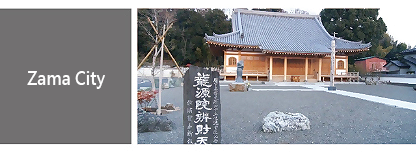

Ryugenin
Ryugenin is famous for being dedicated to Benzaiten (goddess of eloquence) of the Sagami Shichifukujin (Seven Gods of Fortune). It was reportedly founded in 1461 at Iriya Maruyamashita by Kakuun Shuson, the eighth-generation priest of Uenohara Seigenin Temple. A tour of the Sagami Seven Gods of Good Fortune is worthwhile.

Shokokuji Temple
Shokokuji Temple is the eighth temple of the Bando 33 Kannon Pilgrimage. In addition to a temple bell designated as a National Important Cultural Property, the temple is the site of legends known as the Seven Mysteries of Shokokuji, such as the mysterious "Star Well," which shows reflections of stars even in the daytime.

Zama Shrine
Legends say that Zama Shrine got its start after goshinsui (holy water) cured an epidemic. There is a spring under the cliffs on the shrine grounds that has never dried up, and its waters are called the "water of fortune." The view from the shrine grounds has been selected as one of the Eight Views of Zama.

Suzuka and Nagajuku
Suzuka and Nagajuku, two towns with spring water and history, offer beautiful, spacious and pleasant townscapes filled with an atmosphere of tradition, culture and nature.
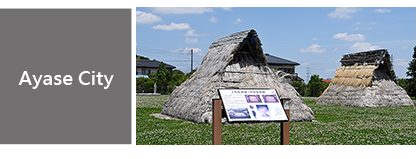

Nationally Designated Historic Site:Kanzaki Archeological Site
Kanzaki Archeological Site is a moated settlement from the late Yayoi Period (about 1,800 years ago) and Nationally Designated Historic Site. It was excavated in an almost complete state, and the ruins were backfilled. The site is maintained as Kanzaki Archeological Site Park.
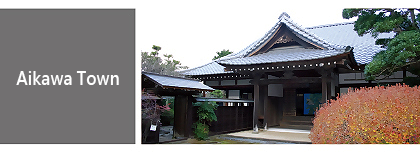

Old 'Minka' Folk House:Yamaju House
Built in 1883 , Yamaju House and its garden have been restored and preserved to teach future generations about the residences of wealthy farmers in the region during the early Meiji Era.

Site of Mimase Battle Field
This site is famous as the battlefield of the Battle of Mimase Pass, where the armies of the Takeda and Hojo clans fought a fierce battle. The monument was erected four centuries later in 1969.
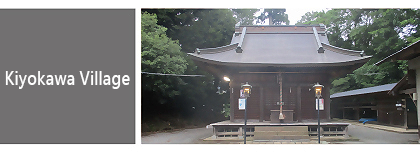
Hachiman Shrine was founded in the Jisho Period (1177-1181) when Mori (Taro) Kageyuki invited the deity of Iwashimizu Hachiman Shrine in Kyoto to the Miyano Forest and the former became a branch shrine.
寺社・史跡・文化財(全16件)
※ 下記のリンクにつきましては、別ウィンドウで開きます。
相模原市
| 史跡・文化財 | 相模原市の文化財とその保護について。史跡紹介、史跡に関するイベントの案内も。〔情報提供〕/相模原市 |
|---|---|
| 市史について | 相模原市市史刊行計画、事務室の案内等。〔情報提供〕/相模原市 |
厚木市
| 文化財・歴史 | あつぎの文化財、厚木市史等。〔情報提供〕/厚木市 |
|---|---|
| 寺社・仏閣 | 厚木市の寺社・仏閣。〔情報提供〕/厚木市 |
| あつぎの文化財 | 厚木市の文化財・史跡。〔情報提供〕/厚木市観光協会 |
大和市
| 文化財 | 大和市の指定文化財等の一覧。〔情報提供〕/大和市 |
|---|---|
| 歴史・文化財刊行物 | 大和市の歴史や文化財について紹介する刊行物の案内。〔情報提供〕/大和市 |
海老名市
| 海老名の民話 | 海老名の民話の一覧。〔情報提供〕/海老名市 |
|---|---|
| 海老名の史跡・文化財 | 海老名の史跡・文化財の一覧。〔情報提供〕/海老名市 |
座間市
| 座間市の歴史 | 原始から現代までの座間市の歴史。〔情報提供〕/座間市 |
|---|---|
| 座間むかしむかし | 座間の歴史や出来事などをまとめた冊子の紹介。〔情報提供〕/座間市 |
綾瀬市
| 文化財 | 彫刻、踊りなど綾瀬市の文化財について。〔情報提供〕/綾瀬市 |
|---|
愛川町
| 愛川の文化財 | 塩川の滝など愛川の史跡・名勝について。〔情報提供〕/愛川町 |
|---|
清川村
| 清川村の歴史 | 古代から現代までの清川村の歴史。〔情報提供〕/清川村 |
|---|---|
| 宮ヶ瀬湖水の郷交流館 | かつての宮ヶ瀬地域の歴史、文化、産業を伝えると同時に、郷土体験の場づくりとして、宮ヶ瀬湖畔にオープンした清川村宮ヶ瀬湖水の郷交流館について。交通案内等。〔情報提供〕/公益財団法人宮ヶ瀬ダム周辺振興財団 |
このページに関するお問い合わせ先
企画調整部商工観光課(厚木合同庁舎内)
電話046-224-1111(内線2521から2523)
このページの所管所属は 県央地域県政総合センターです。

